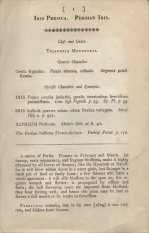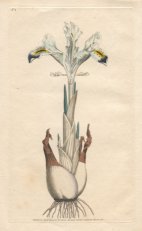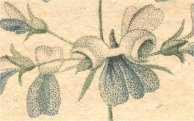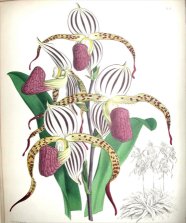|
The Botanical magazine, or, Flower-garden displayed / by William Curtis.
[London : Printed for W. Curtis by S. Couchman]
Vol. 1 [(1787)]-v. 14 (1800).
Volume 1, plate 1 "Iris Persica"
  The Botanical Magazine was started by William Curtis for the express purpose of illustrating and describing exotic plants found in English gardens. His first publication Flora Londinensis received praise for its large carefully reproduced illustrations of plants that grew within ten miles of London. However, its expense could not be supported. Curtis then turned to a smaller size and concentrated on the colorful. His magazine was issued in parts starting in 1787 and under different names and publishers is still being published today. Note the reference to John Parkinson's Paradisi in sole paradisvs terrestris at the end of the description.
The Botanical Magazine was started by William Curtis for the express purpose of illustrating and describing exotic plants found in English gardens. His first publication Flora Londinensis received praise for its large carefully reproduced illustrations of plants that grew within ten miles of London. However, its expense could not be supported. Curtis then turned to a smaller size and concentrated on the colorful. His magazine was issued in parts starting in 1787 and under different names and publishers is still being published today. Note the reference to John Parkinson's Paradisi in sole paradisvs terrestris at the end of the description.
Hunt 689
The hand-colored engraving is the first part issued.
Nuttall, Thomas, 1786-1859.
"Description of Collinsia, a new genus of plants"
Volume 1 (1817), page 189-192 of:
Journal of the Academy of Natural Sciences of Philadelphia.
Plate IX "Collinsia"
 The Academy was interested in all varieties of the natural sciences, so naturally it is a good place to search for botanical illustrations. Thomas Nuttall was a British botanist and ornithologist who came to the United States in 1805 and returned to England in 1842. During his time in America, he traveled extensively, published numerous works, primarily on botany, and was the curator of the gardens at Harvard University from 1825 to 1834. This particular article describes a plant he first collected, then lost, near Lake Erie on an expedition in the spring of 1810. In the spring of 1816, he returned to the region and found another specimen near the Ohio River.
The Academy was interested in all varieties of the natural sciences, so naturally it is a good place to search for botanical illustrations. Thomas Nuttall was a British botanist and ornithologist who came to the United States in 1805 and returned to England in 1842. During his time in America, he traveled extensively, published numerous works, primarily on botany, and was the curator of the gardens at Harvard University from 1825 to 1834. This particular article describes a plant he first collected, then lost, near Lake Erie on an expedition in the spring of 1810. In the spring of 1816, he returned to the region and found another specimen near the Ohio River.
The illustration is a stipple engraving colored a la poupée drawn by Charles Alexandre Lesueur. He was a naturalist who was the expedition artist on a voyage of discovery in the seas about Australia, came to Philadelphia in 1816, and soon became the curator of the Academy of Natural Science, moved to Indiana 1825-1834, returned to France in 1835, and became curator of the museum at Le Havre, 1845-1846.
Not all issues of this engraving are colored. The Rare Book Collection has another copy from the personal library of the naturalist Louis Agassiz that is printed in plain black ink.
Stipple engraving printed in color.
Stipple-engraving à la Poupée - Intaglio
 Stipple engraving uses the burin or a special tool like a punch with irregular teeth on one end, a mattoir. Small bits of the metal plate could be flicked off the surface with the burin or a pattern of dots. Like an engraving, the plate would be covered with ink and the excess on the surface wiped off. This method produces a tonal quality. In this example, each color has been applied to the plate separately with a dauber known as a poupée. Each color would be applied to the plate at the same time, so the plate would go through the press only once.
Stipple engraving uses the burin or a special tool like a punch with irregular teeth on one end, a mattoir. Small bits of the metal plate could be flicked off the surface with the burin or a pattern of dots. Like an engraving, the plate would be covered with ink and the excess on the surface wiped off. This method produces a tonal quality. In this example, each color has been applied to the plate separately with a dauber known as a poupée. Each color would be applied to the plate at the same time, so the plate would go through the press only once.
Paxton's magazine of botany, and register of flowering plants.
London : Orr and Smith, 1834-1849.
v. 1-16; 1834-1849.
Volume 1, pages 54-63
"Minulos Smithii (Mrs. Smith's Monkey Flower)"
 Like the Botanical Magazine of William Curtis, John Paxton's periodical is devoted to the illustration in color of new and uncommon plants grown in British gardens. Although primarily horticultural in appeal, it contains the first descriptions of many new species. It is clearly designed to be a popular journal with appeal to the informed amateur.
Like the Botanical Magazine of William Curtis, John Paxton's periodical is devoted to the illustration in color of new and uncommon plants grown in British gardens. Although primarily horticultural in appeal, it contains the first descriptions of many new species. It is clearly designed to be a popular journal with appeal to the informed amateur.
Hand-colored spirit aquatint with added etching and engraving.
Hand-colored Spirit Aquatint - Intaglio
 In spirit aquatint, the ground is dissolved in a medium such as alcohol and poured over the plate. As the alcohol evaporates, the ground forms distinctive patterns, most often like the cracking pattern of a dried up mud puddle. By using different grounds, the patterns can be altered in predictable ways, some less circular and more linear.
In spirit aquatint, the ground is dissolved in a medium such as alcohol and poured over the plate. As the alcohol evaporates, the ground forms distinctive patterns, most often like the cracking pattern of a dried up mud puddle. By using different grounds, the patterns can be altered in predictable ways, some less circular and more linear.
The orchid album, comprising coloured figures and descriptions of new, rare, and beautiful orchidaceous plants. / Conducted by Robert Warner, and Benjamin Samuel Williams ; the botanical descriptions by Thomas Moore ; the coloured figures by John Nugent Fitch.
London, B.S. Williams, 1882-97.
11 v., 528 plates : col. ill. ; 32 cm.
Volume 1, plate 8
"Cypripedium stonei"
 The Album was started in response to the great interest in England in growing orchids, the more exotic the better. It was designed to satisfy the expectations and needs of growers, both commercial and amateur.
The Album was started in response to the great interest in England in growing orchids, the more exotic the better. It was designed to satisfy the expectations and needs of growers, both commercial and amateur.
"Being of Royal Quarto size, the pages of the Album are sufficiently large to enable to artist to produce ample and intelligible portraits of the plants ... Thus we trust we may be permitted to lay before our patrons an acceptable Annual Album of Floral Pictures, which will be, at once, welcomed both to the Drawing-room and the Library."
John Nugent Fitch both drew and lithographed the plates. He was the nephew of the celebrated Walter Hood Fitch and continued his uncle's work for the Botanical magazine.
Hand-colored lithographs.
|
![]()

![]()

![]()